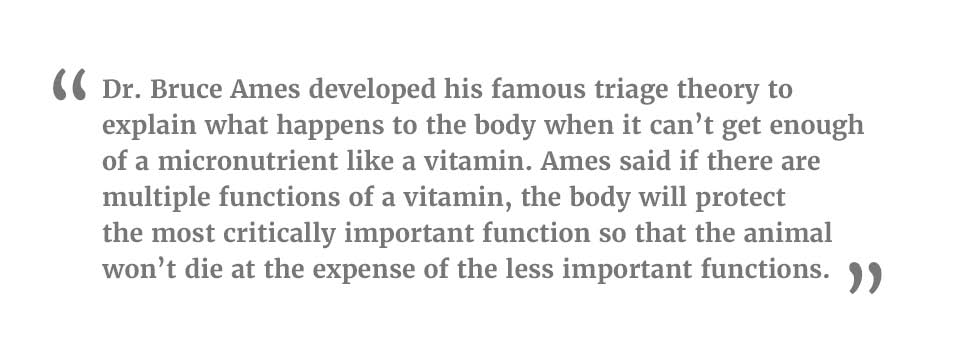In this three-part blog series, Dr. Jeffrey Bland and Dr. Leon Schurgers explain the science behind the interaction of warfarin and vitamin K in the body, how this interaction could lead to vascular calcification, and the potential ways to reverse the calcification process.
Vitamins have captured the attention of health-conscious people ever since the term “vitamin” was coined in 1912. Named “vita” for life or life-giving and “amin” for amine compounds, scientists now know much more about these crucial dietary components, including the fact that not all vitamins contain amine groups. There is still more to learn about how vitamin intake from our diets prevents or causes disease, or how diseases may cause vitamin deficiencies. But some experts are raising a new concern: that the common drug warfarin is actually contributing to disease by interfering with vitamin K.
Vitamin K is crucial to our body’s blood clotting ability, and warfarin works to prevent blood clots by decreasing the blood-clotting action of vitamin K. But from a knowledge of biochemical reactions in the human body and studies of people taking warfarin, many are now worried that physicians may be causing unintended negative consequences for their patients.
The Discovery of Vitamin K
From 1915 through 1930, medicine underwent a huge turning point in the discovery and understanding of vitamins. Scientists found several new types of vitamins and realized that—other than thiamine, riboflavin and
niacin—many vitamins are not amines as they do not have nitrogen in them. Yet, they were still called vitamins (life-giving amines) because they were vital constituents within food. If vitamins are absent from a diet, it will lead to a demonstrable
physiological dysfunction that scientists would label as a disease. In the case of vitamin C, the disease would be scurvy; in the case of niacin, it would be pellagra.
It was around this time that experiments linked the efficacy of some vitamins to fat in the diet. Between 1928 and 1930, Carl Peter Henrik Dam of Copenhagen University observed that chicks fed a fat-free diet for three weeks developed spontaneous bleeding.
This bleeding could be tied back to deficiency in the blood clotting factor prothrombin. These findings were originally publish in a German journal; hence, vitamin K was named for the German word “koagulation.”
In 1930, Edward Adelbert Doisy worked to uncover the structure of vitamin K. He found it was a small molecule that was not a protein, and it had an anthraquinone structure. This structure interests chemists because it means the molecule has redox
potential.
Vitamin K can be found in kale, spinach, alfalfa and liver, among other foods. It exists in several forms called vitamers. There is vitamin K1 and vitamin K2, which can be further classified into different groups based on the side chains attached to the vitamin K2 molecule. The menaquinones called MK-4 and MK-7 are examples of vitamin K2.
Vitamin Deficiency and Triage Theory
Vitamin K is primarily known for its role in blood clots. However, as Linus Pauling explained, whenever there is a change in the structure of a molecule, there is a change in its function. This means that because
vitamin K has various forms, it should have various functions, which would complicate what happens in the body when warfarin interferes with vitamin K.
Dr. Bruce Ames developed his famous triage theory to explain what happens to the body when it cannot get enough of a micronutrient like a vitamin. Ames said if there are multiple functions of a vitamin, the body will protect the most critically important function so that the animal won’t die at the expense of the less important functions. Ames applied this concept to vitamin K and determined that in the tier of lethality for animals coagulation (blood clotting) reigns supreme. Think of an animal that gets a cut or wound. If that animal’s blood won't clot—if it has coagulopathies—the life of that animal is in immediate jeopardy, and its body better control the bleeding first.

Vitamin K participates in two general processes in the body. One is in coagulation, the other has to do with the transport of calcium in different tissues and is not directly associated with coagulation. Vitamin K has vascular effects in which calcium
can be pulled out of tissues by the right form of vitamin K. There are also other forms of co-catalyzation of vitamin K in which calcium is put into tissues, like the osteoblast, and the body starts laying down calcium and bone.
According to the triage theory, if an animal or human has limited or inhibited vitamin K, the body will sacrifice some of the vitamin K function at the vascular or bone level to keep that animal’s coagulation parameters functioning.
Vitamin K's Function and Chemistry in the Body
Vitamin K’s function relates to a family of reactions that are called carboxylation reactions. Carboxylation is really the addition of carbon dioxide to an amino acid, which is part of a residue of a protein.
Another carboxylic acid residue is actually produced by this carboxylation reaction.
Across a variety of studies, researchers have found a strong correlation between uncarboxylated proteins and cardiovascular disease. Uncarboxylated proteins are also beginning to show up in association with other diseases, such as diabetes.
Vitamin K, Glucose and Diabetes
A systematic review published in 2017 in the European Journal of Endocrinology found that markers of both bone formation and resorption are decreased in patients with diabetes, indicating that diabetes mellitus is a state of low bone turnover. Altered levels of bone-derived hormones may be responsible for this. Vitamin K might be thought of as being a member of the pro-hormone family by having hormone-mediated endocrine-like effects similar to vitamin D.
Additionally, a 2017 review published in
the Endocrine Journal (from The Japan Endocrine Society) claimed that bone has recently been recognized as an endocrine organ in some circles due to this interaction between bone and glucose. Previous studies have shown that osteocalcin, which
is preferentially expressed in osteoblasts and secreted into circulation, may regulate glucose homeostasis. The ratio of carboxylated osteocalcin to uncarboxylated osteocalcin, which is mediated by vitamin K, is a surrogate marker and potentially
a risk factor of diabetes.
This is still an area of growing research, but it shows there’s a lot more to the story of vitamin K than just blood clotting.
Check out part 2 and part 3 for more insights on vitamin K.

Jeffrey Bland, PhD, FACN, CNS has been an internationally recognized leader in the nutritional medicine field for over 35 years and is known for his ability to synthesize complex scientific concepts in a manner that is both personable and accessible. A biochemist by training, Dr. Bland earned dual degrees in biology and chemistry from the University of California, Irvine and completed his PhD in organic chemistry at the University of Oregon. He is a Fellow of both the American College of Nutrition where he is a Certified Nutrition Specialist and the Association for Clinical Biochemistry.

Leon Schurgers, PhD is a Senior Scientist and Professor of Biochemistry of Vascular Calcification at the Cardiovascular Research Institute Maastricht (CARIM), Maastricht University. Prof. Schurgers’
work includes molecular biology, biochemistry, animal and human nutrition, pharmacology, and clinical studies in the fields of vascular disease. He is leading the scientific part on vitamin K research and supervising technical engineers, post docs and PhD students.
Prof. Schurgers is a member of the International Society on Thrombosis and Haemostasis as well as the American Heart Association. He has published more than 130 research papers in the international scientific press.




